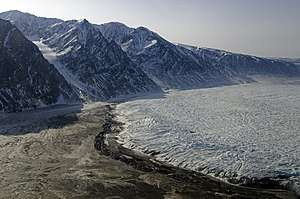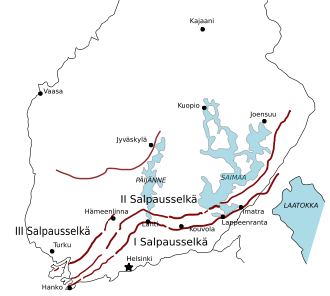Terminal moraine
A terminal moraine, also called end moraine, is a type of moraine that forms at the snout (edge) of a glacier, marking its maximum advance. At this point, debris that has accumulated by plucking and abrasion, and has been pushed by the front edge of the ice, is driven no further and instead is dumped in a heap. Because the glacier acts very much like a conveyor belt, the longer it stays in one place, the greater the amount of material that will be deposited. The moraine is left as the marking point of the terminal extent of the ice.[1]


Examples
Terminal moraines are one of the most prominent types of moraines in the Arctic. One notable terminal moraine is Trollgarden in Norway, once thought to be magically constructed by trolls.
In North America, the Outer Lands is a name given to the terminal moraine archipelago of the northeastern region of the United States (Cape Cod, Martha's Vineyard, Nantucket, Block Island and Long Island). According to geologist George Frederick Wright some of the most prominent examples of terminal moraines on Long Island are "the most remarkable in the world".[2] Other prominent examples of terminal moraines are the Tinley Moraine and the Valparaiso Moraine, perhaps the best examples of terminal moraines in North America. These moraines are most clearly seen southwest of Chicago.
In Europe, virtually all the terrain in the central Netherlands is made up of an extended terminal moraine. In Switzerland, alpine terminal moraines can be found, one striking example being the moraine at the end of the valley of the Forno Glacier in the south-eastern canton of Graubünden near St. Moritz and the Italian border.
In New Zealand the Franz Josef Glacier on the West Coast has created the terminal moraine called the Waiho Loop.
.jpg)
See also
- Glacial landform
- Postglacial rebound
- Push moraine
- Outwash plain
- Trafalgar Moraine
- Oak Ridges Moraine
- List of glacial moraines
References
- H.-E. Reineck; I. B. Singh (6 December 2012). Depositional Sedimentary Environments: With Reference to Terrigenous Clastics. Springer Science & Business Media. pp. 170–. ISBN 978-3-642-96291-2.
- Wright, G. Frederick (1889). The Ice Age in North America. D. Appleton and Company. pp. 176.